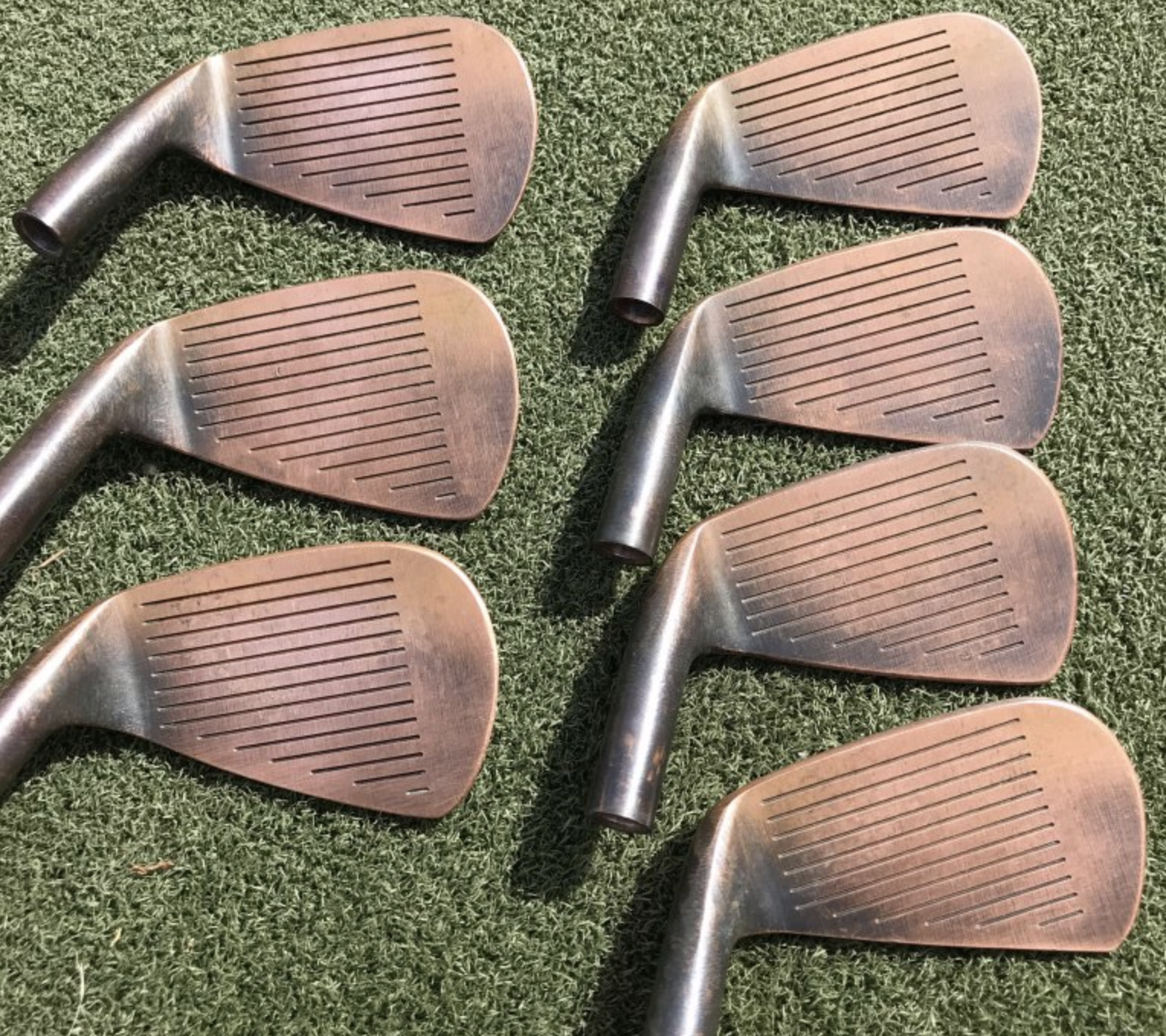News
The Wedge Guy: A defense of blades

One of the longest-running and most active conversations in all of golf equipment is the subject of blades versus game improvement irons. Over the nearly 20 years I’ve been writing this blog as “The Wedge Guy,” I’ve addressed this in various ways and always stimulated a lively discussion with my readers.
I hope this angle on the conversation will do the same, so all of you please share your thoughts and observations.
In the interest of full disclosure, I have always played some kind of blade-style irons, with only a few detours along the way. But I always come back to my blades, so let me explain why.
I grew up in the 1950s and 60s when blades were all we had. As a teenager with a developing skill set, I became a devotee to those models from the old Ben Hogan Company, and played the “Bounce Sole” model, then several iterations of the Apex line after it was introduced. Those few sets served me well into my 30s, when I became involved in the golf equipment industry. Having Joe Powell Golf as a client, I switched to his pure muscle back model called the “PGI.” They were certainly sweet.
In the late 1980s, I was handling the marketing for Merit Golf, who offered a cavity back forging called the Fusion, which was inspired by the Ben Hogan Edge irons, but offered a more traditional face profile. So, I switched to them.
Playing to a low single digit handicap at the time, I really didn’t see my scores change, but I just wasn’t making as many birdies as I had before. Openly pondering why my golf felt different, a regular golf buddy noted, “You’re not knocking down pins as often as you used to,” and I realized he was right. I was hitting just as many greens as before, maybe one or two more, but I wasn’t getting those kick-in birdies nearly as often. So, I went to the closet and broke out the old Joe Powell PGI irons and had an epic day with three birdies inside five feet and a couple more in the 5-10 range.
Those blades stayed in the bag until I developed my first iron design, the “RL blades” by my first company, Reid Lockhart. By this time, I had seen enough robotic testing prove that the most penalizing mishit with a blade was a toe impact, which mirrored my own experience. So, I sculpted a pure muscle back blade, but added a bit of mass toward the toe to compensate for that deficiency of all such designs.
I played those irons for 20 years, until I created the “FT. WORTH 15” irons for the re-launch of the Ben Hogan brand in 2015. In that design, I further evolved my work to very slightly add a bit of modified perimeter weighting to a pure forged blade, taking inspiration from many of Mr. Hogan’s earlier personal designs in the Apex line of the “old” Ben Hogan Company. Those are still in my bag, going on eight years now.
So, why do I think I can make a solid defense for playing blade irons? Because of their pinpoint distance control, particularly in the short irons — those with lofts of 35 degrees or higher.
I’ll certainly acknowledge that some modern perimeter weighting is very helpful in the lower lofts . . .the mid- and long irons. In those clubs, somewhere on or near the green is totally acceptable, whether you are playing to break 90 or trying to win on the PGA Tour. [Did you know those guys are actually over par as a group outside 9-iron range?] That’s why you see an increasing number of them playing a conservative game-improvement design in those lofts. But also remember that we in the golf club design business deal with poor “hits” only . . . we have no control over the quality of your swing, so the vast majority of bad golf shots are far beyond our influence.
But what I’ve seen in repeated robotic testing and in my own play, when you get to the prime scoring clubs – short irons and wedges – having a solid thickness of mass directly behind the impact point on the face consistently delivers better distance control and spin. In my own designs of the SCOR wedges in 2010, and the Ben Hogan FT.WORTH 15 irons and TK15 wedges, I created a distribution of mass that actually placed a bit more face thickness behind the slight mishit than even in the center, and the distance consistency was remarkable.
I’ve carried that thinking to the Edison Forged wedges by positioning much more mass behind the high face and toe miss than any other wedges on the market. And in robotic testing, they deliver better transfer of energy on those mishits than any other wedge we tested.
So, back to that experience when I switched back to my Joe Powell blades from the Merit cavity back forging, I can sum it up this way.
If your pleasure from your golf is derived more from how good your worst shots turn out, then a game improvement iron is probably the way to go. But if your golf pleasure is more about how good your best shots are, I think there is a very strong case to be made for playing some kind of blade iron design, at least in your scoring clubs.
Alright, fans: sound off!
News
Tour Rundown: Bend, but don’t break

I’m going to gush in this intro paragraph, to get the emo stuff done early. I’ve not pulled harder for a professional to win, than Cameron Young. I coach golf in New York state, and each spring, my best golfers head to a state championship in Poughkeepsie. I first saw Cameron there as a 9th grade student. I saw him three more times after that. I reconnecected with Coach Haas from Wake Forest, an old interview subject from my days on the Old Gold and Black, the Wake newspaper. He was there to watch Cameron. After four years at Wake Forest, Young won on the Korn Ferry Tour, made it to the big tour, almost won two majors, almost won five other events, and finally got the chalice about 25 minutes from the Wake campus. Congratulations, Cameron. You truly are a glass of the finest. #MotherSoDear
OK, let’s move on to the Tour Rundown. The major championship season closed this week in Wales, with the Women’s Open championship. The PGA Tour bounced through Greensboror, N.C., while the PGA Tour Americas hit TO (aka, Toronto) for a long-winded event. The Korn Ferry lads made a stop in Utah, one of just two events for that tour in August. The many-events, golf season is winding down, as we ease from summer toward fall in the northern hemisphere. Let’s bask in the glory of an August sunrise, and run down a quartet of events from the first weekend of the eighth month.
LET/LPGA @ Women’s Open: Miyu bends, but she doesn’t break
Royal Porthcawl was not a known commodity in the major tournament community. The Welsh links had served as host to men’s senior opens, men’s amateurs, and Curtis and Walker Cups in prior years, but never an Open championship for the women or the men. The last-kept secret in UK golf was revealed once again to the world this week, as the best female golfers took to the sandy stage.
Mao Saigo, Grace Kim, Maja Stark, and Minjee Lee hoped to add a second major title to previous wins this season, but only Lee was able to finish inside the top ten. The 2025 playing of the Women’s Open gave us a new-faces gallery from day one. The Kordas and Thitikulls were nowhere to be found, and it was the Mayashitas, Katsus, and Lim Kims that secured the Cymru spotlight. The first round lead was held at 67 by two golfers. One of them battled to the end, while the other posted 81 on day two, and missed the cut. Sitting one shot behind was Miyu Yamashita.
On day two, Yamashita posted the round of the tournament. Her 65 moved her to the front of the aisle, in just her fourth turn around a women’s Open championship. With the pre-event favorites drifting off pace, followers narrowed into two camps: those on the side of an underdog, and others hoping for a weekend charge from back in the pack. In the end, we had a bit of both.
On Saturday, Yamashita bent with 74 on Saturday, offering rays of hope to her pursuing pack. England’s Charley Hull made a run on Sunday closing within one shot before tailing off to a T2 finish with Minami Katsu. Katsu posted the other 65 of the week, on Saturday, but could not overtake her countrywoman, Yamashita. wunderkind Lottie Woad needed one round in the 60s to find her pace, but could only must close-to’s, ending on 284 and a tie with Minjee for eighth.
On Sunday, Yamashita put away the thoughts of Saturday’s struggles, with three-under 33 on the outward half. She closed in plus-one 37, but still won by two, for a first Major and LPGA title.
PGA Tour @ Wyndham: Young gathers first title near home
Cameron Young grew up along the Hudson river, above metro New York, but he also calls Winston-Salem home. He spent four years as a student and athlete at Wake Forest University, then embarked on tour. This week in Greensboro, after a bit of a break, Young opened with 63-62, and revved the engine of Is this the week once more. Runner-up finishes at the Open, the PGA, and a handful of PGA Tour events had followers wonder when the day would come.
On Saturday, Young continued his torrid pace with 65, giving him a five-shot advantage over his closest pursuer. Sunday saw the Scarborough native open with bogey, then reel off five consecutive birdies to remind folks that his time had, at last, arrived. Pars to the 16th, before two harmless bogeys coming home, made Young the 1000th winner of an official PGA Tour event (dating back to before there was a PGA Tour) throughout history. What’s next? I have a suspicion, but I’m not letting on. Mac Meissner closed with 66 to finish solo 2nd, while Mark Hubbard and Alex Noren tied for third.
Korn Ferry Tour @ Utah Championship: Are you Suri it’s Julian?
Who knows exactly when the flower will bloom? Julian Suri played a solid careet at Duke University, then paid his dues on the world’s minor tours for three years. He won twice on two tours in Europe, in 2017. Since then, the grind has continued for the journeyman from New York city. At age 34, Suri broke through in Beehive state, outlasting another grinder (Spencer Levin) and four others, by two shots.
Taylor Montgomery began the week with 62, then posted 64, then 68, and finally, 70. That final round was his undoing. He finished in that second-place tie, two back of the leader. Trace Crowe, Barend Botha, and Kensei Hirata made up the last of the almost quintet. As for Suri, his Sunday play was sublime. His nines were 32 and 31, with his only radar blip a bogey at ten. He closed in style with one final birdie, to double his winning margin. Hogan bloomed late…might Suri?
PGA Tour Americas @ Osprey Valley Open presented by Votorantim Cimentos – CBM Aggregates
Some tournament names run longer than others. This week in Toronto, at the Heathlands course at TPC Toronto, we might have seen the longest tournament title in recorded history. The OVOPBVCCBMA was a splendid affair. It saw three rounds of 62 on Thursday, but of those early risers, only Drew Goodman would stick around until the end. 64 was the low tally on day two, and two of those legionnaires managed to finish inside the top three at week’s end. Saturday brought a 63 from Patrick Newcomb, and he would follow with 64 on Sunday, to finish solo fourth.
Who, then, ended up winning the acronym of the year? It turns out that Carson Bacha had the right stuff in TeeOhhh. Bacha and Jay Card III posted 63 and 64, respectively, on day four, to tie for medalist honors at 23-under 261. Nathan Franks was one shot adrift, despite also closing with 63. If you didn’t go low on Sunday, it was about the check, not the championship.
Bacha and JC3 returned to the 18th hole twice in overtime. Card nearly chipped in from the thick stuff for birdie, while Bacha peeked and shoved a ten-feet attempt at the win. On the second go-round, Card was long with his approach, into the native grasses once more. He was unable to escape, and a routine par from the fairway was enough to earn the former Auburn golfers a first KFT title.
Card III and Bacha both miss their birdie tries on the first playoff hole.
We’ll play 18 again @OspreyOpen. pic.twitter.com/vNpHTdkHDg
— PGA TOUR Americas (@PGATOURAmericas) August 3, 2025
Tour Photo Galleries
Photos from the 2025 Wyndham Championship

GolfWRX is live this week from the final event of the PGA Tour’s regular season, the Wyndham Championship.
Photos are flowing into the forums from Sedgefield Country Club, where we already have a GolfWRX spirit animal Adam Schenk WITB and plenty of putters for your viewing pleasure.
Check out links to all our photos below, which we’ll continue to update as more arrive.

General Albums
- 2025 Wyndham Championship – Tuesday #1
- 2025 Wyndham Championship – Tuesday #2
- 2025 Wyndham Championship – Tuesday #3

WITB Albums
- Chandler Phillips – WITB – 2025 Wyndham Championship
- Davis Riley – WITB – 2025 Wyndham Championship
- Scotty Kennon – WITB – 2025 Wyndham Championship
- Austin Duncan – WITB – 2025 Wyndham Championship
- Will Chandler – WITB – 2025 Wyndham Championship
- Kevin Roy – WITB – 2025 Wyndham Championship
- Ben Griffin – WITB – 2025 Wyndham Championship
- Peter Malnati – WITB – 2025 Wyndham Championship
- Ryan Gerard – WITB – 2025 Wyndham Championship
- Adam Schenk – WITB – 2025 Wyndham Championship
- Kurt Kitayama – WITB – 2025 Wyndham Championship
- Camilo Villegas – WITB – 2025 Wyndham Championship
- Matti Schmid – WITB – 2025 Wyndham Championship
Pullout Albums
- Denny McCarthy’s custom Cameron putters – 2025 Wyndham Championship
- Swag Golf putters – 2025 Wyndham Championship
- Karl Vilips TM MG5 wedges – 2025 Wyndham Championship
- New Bettinardi putters – 2025 Wyndham Championship
- Matt Fitzpatrick’s custom Bettinardi putters – 2025 Wyndham Championship
- Cameron putters – 2025 Wyndham Championship

See what GolfWRXers are saying and join the discussion in the forums.
News
BK’s Breakdowns: Kurt Kitayama’s Winning WITB, 3M Open

Kurt Kitayama just won his 2nd PGA Tour event at the 3M Open. Kurt is a Bridgestone staffer but with just the ball and bag. Here are the rest of the clubs he used to secure a win at the 2025 3M Open.
Driver: Titleist GT3 (11 degrees, D1 SureFit setting)
Shaft: Graphite Design Tour AD VF 7 TX
3-wood: Titleist GT1 3Tour (14.5 degrees, A3 SureFit setting)
Shaft: Graphite Design Tour AD DI 8 TX
7-wood: Titleist GT1 (21 degrees, A1 SureFit setting)
Shaft: Graphite Design Tour AD DI 9 TX
Irons: TaylorMade P7CB (4), TaylorMade P7MB (5-PW)
Shafts: True Temper Dynamic Gold Tour Issue X100
Wedges: Titleist Vokey Design SM10 (52-12F, 56-14F), Vokey Design WedgeWorks (60-K*)
Shafts: True Temper Dynamic Gold Tour Issue S400
Putter: Scotty Cameron Studio Style Newport 2 Tour Prototype
Grip: SuperStroke Zenergy 1.0PT
Grips: Golf Pride Tour Velvet
Ball: Bridgestone Tour B XS (with Mindset)




















Pingback: The Wedge Guy: The critical transition factor – GolfWRX
Drew
Sep 30, 2022 at 7:22 pm
So your playing vokey wedges, but game improvement irons of a different(non Titleist) brand. How would one incorporate blades into this setup. But some Titleist 8-PW blades or go with blades of the same manufacture as your game improvement irons? I think a part 2 may be needed for this article
Pingback: The Wedge Guy: A Tale of Two Misses – GolfWRX
Not Biden
Sep 27, 2022 at 7:14 pm
What is the authors playing background? How often does he shoot under par? I take no advice from somebody who’s not scratch or better.
+3.1 myself.
Try
Sep 23, 2022 at 7:19 pm
Nonsense. Give me the largest game improvement iron you can find and you play your blades and I’ll still beat you
Brian
Sep 26, 2022 at 2:23 pm
Suuuure you will. It’s your story, tell it however you want.
MarkM
Sep 23, 2022 at 1:46 pm
I grew up with blades, as I started playing golf in the 70s. I have gone back and forth between blades and CBs but always seem to return to blades for the same reason you cited – the feeling of hitting that pure shot and knowing it will go the distance you want. Currently playing Honma T//W Rose Proto irons
Dennis
Sep 23, 2022 at 12:08 am
Don‘t you need a certain swing speed to play blades?
Brian
Sep 26, 2022 at 2:22 pm
In the 3 – 6i you do. If you don’t have enough speed, your gaps will bunch up in the mid-long irons.
Dan
Sep 22, 2022 at 10:49 pm
Thanks for An enjoyable read. I briefly had RL blades around 2003 and forgotI had them till I read this.
WYBob
Sep 22, 2022 at 7:56 pm
I agree with you 100%. I am about the same age as you and started playing forged blades in the mid-’60s on tight lies and some tough courses in Texas. As you say, they were the only thing available at the time. A modern GI club just does not fit my eye and I hit them worse than most modern MB irons. My favorite irons are still the Ben Hogan FTX from the early 2000s which was a mixed MB (E-7) and CB (6-3)set designed as an integrated set. I still have them plus several sets of Hogan Apex and a set of Hogan Fort Worth irons that I pull out from time to time to test my ball striking (and honestly for nostalgia purposes). However, as a concession to age, I have built out a combo set of irons that take advantage of current technology in an effort to regain some of the distance lost due to age. The primary difference from the FTX is that my current MBs run 8-PW. Thanks for your insights and affirmation that my current thinking about iron set makeup has some merit. cheers…
Nick
Sep 22, 2022 at 6:02 pm
This is my idea for my set of irons is to have players distance in the 4-7irons and get more blade like irons in 8-W
Karsten Solheim
Sep 22, 2022 at 1:24 pm
I had it figured out in 1982 Terry. Certain folks didn’t like it when I took their market share.
Stosh
Sep 22, 2022 at 12:46 pm
I completely agree with your argument. And during my years of trying and buying new clubs, I have found the a mixed set of clubs – blades in the short irons – gave me not only great consistency but the ability to hit a broader variety of shots with control. I encourage golfers, mid to low handicaps to try this set up.